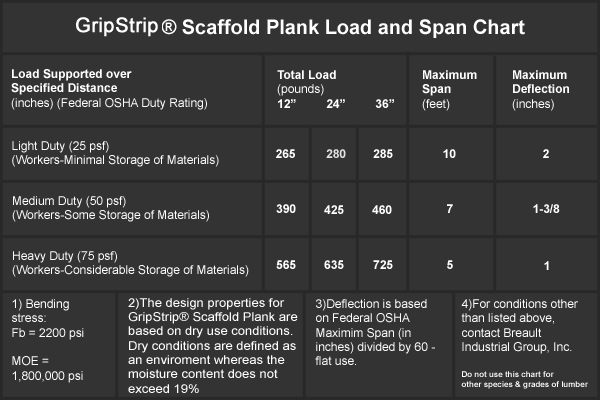Technical Specifications
Our manufacturing process starts with the highest fiver-quality, then we remove all necessary defects. Next, we hydraulically press hardened steel pins into the plank ends to stop end splints. All planks are continuously branded from end to end on both sides with your name, the OSHA compliance stamp and manufacture date to protect and confirm your investment, all of which combines to provide you with the safest, longest-lasting scaffold planks backed by the best safety rating in the industry - ZERO FAILURES! A safer plank helps reduce costs - make the 'sold choice', GripStrip® Scaffold Planks.
Care and Handling
Proper storage, handing and disposal of scaffold planks are as important and proper inspection. Scaffold planks should be inspected immediately upon delivery, as well as each time they go out to and come back from your facility or job site. Damage to the plank can be prevented by proper storage and handling.
You disposal choices are very important as well. Discard damaged planks, damaged planks must never end up being used as scaffold planks at a later time.
Stacking
It is important that scaffold planks be stacked off the ground, to allow air circulation throughout the bundles. This helps prevent moisture retention, decay and insect contamination. Recommended dunnage is 4'x 4'timber or pallet stock; these can also be used between the bundles of planks as sticking.
Banding your planks can also make it easier for stacking and handling when utilizing a forklift. The planks can be bundled in a convenient quantity and should be stored by length.
Prevent decay and dry rot by covering the plank stacks before they become wet. Keep in mind, covering the planks without proper sticking and ventilation may cause decay. Confer with a competent or qualified person for the best procedure for covering plank.
Disposal
A good way to prevent discarded planks from accidentally being reused is to cut them into sills or non-usable lengths. Never dump or abandon damaged plank, as it may end up being used by someone else. If you are discarded contaminated planks, be sure to follow any regulatory requirements based on the type of contaminates.
It is never a good idea to burn contaminated planks as a disposal method. The different chemicals associated with concrete, mortar, plaster and the petrochemical fields may give off harmful fumes and cause particles to become airborne, polluting the air.
Please note, this information does not attempt to be all-inclusive or replace other additional safety measures, conflict with or supersede any laws, government relations, codes or ordinances.
This information has been compiled with the assistance of the Scaffold Industry Association. Please refer to their publication, "A Pocket Handbook Guide on Solid Sawn Wood Scaffold Plank" for more information.

